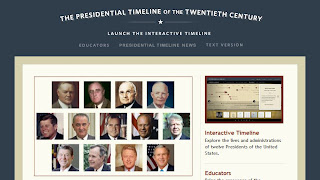(Of course students can use Wikipedia, which often has good articles. Why not stop there? (1) Some Wikipedia articles are written in a style that is hard for some students to read. (2) Some teachers don't want students to cite Wikipedia. (3) Wikipedia articles are unsigned. (4) Wikipedia articles don't give you access to all the great documents and images available in some of the sites listed here.)
Whitehouse.gov is the official site for the current administration. It has short biographies of the presidents here.
The site lists its source:
The Presidential biographies on WhiteHouse.gov are from “The Presidents of the United States of America,” by Michael Beschloss and Hugh Sidey. Copyright 2009 by the White House Historical Association.
The Presidential Timeline of the Twentieth Century gives you easy access to digitized material (documents, audio, video) from the 13 Presidential Libraries that are part of the National Archives. It includes: Herbert Hoover, Franklin D. Roosevelt, Harry S. Truman, Dwight D. Eisenhower, John F. Kennedy, Lyndon B. Johnson, Richard Nixon, Gerald R. Ford, Jimmy Carter, Ronald Reagan, George H. W. Bush, William Jefferson Clinton, and George W. Bush.
In addition to the timeline, there are "exhibits" on special topics for most of the presidents—for example, President Truman's decision to use the atomic bomb (1945) and the desegregation of the armed forces (1948-1954).
You can learn more about the Presidential Libraries and find links to them on the National Archives site. This search page lets you search the Presidential Libraries' websites.
Many of the Presidential Libraries' websites have special pages for students. For instance, the Kennedy Library has For Students, the Johnson Library has LBJ for Kids!, and the Eisenhower Library has Student Resources. You can often find these pages under Education.
Some of the "kids" pages will be useful for younger students. Some are written at a high school level.
The American Presidency Project at UC Santa Barbara pulls together thousands of documents into one searchable database. You can find speeches, papers, party platforms, and more.
Do you like data? This site also gives you data comparing presidents on number of major speeches made, approval ratings, budget information, and more.
If you want to go directly to the audio and video materials, click on media.
The Library of Congress site, America's Story from America's Library (designed for young people), includes U.S. Presidents. It includes 14 presidents.























